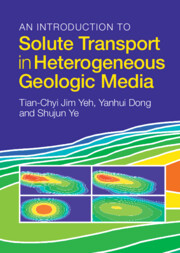Refine search
Actions for selected content:
5487 results in Thermal-fluids engineering
Copyright page
-
- Book:
- A Student's Guide to the Navier-Stokes Equations
- Published online:
- 10 March 2023
- Print publication:
- 09 February 2023, pp iv-iv
-
- Chapter
- Export citation
7 - Solute Transport in Soil Columns
-
- Book:
- An Introduction to Solute Transport in Heterogeneous Geologic Media
- Published online:
- 02 February 2023
- Print publication:
- 09 February 2023, pp 174-201
-
- Chapter
- Export citation
3 - Well-Mixed Models for Subsurface Water Quality Analysis
-
- Book:
- An Introduction to Solute Transport in Heterogeneous Geologic Media
- Published online:
- 02 February 2023
- Print publication:
- 09 February 2023, pp 60-92
-
- Chapter
- Export citation
6 - Shear Flow Dispersion
-
- Book:
- An Introduction to Solute Transport in Heterogeneous Geologic Media
- Published online:
- 02 February 2023
- Print publication:
- 09 February 2023, pp 157-173
-
- Chapter
- Export citation
References
-
- Book:
- An Introduction to Solute Transport in Heterogeneous Geologic Media
- Published online:
- 02 February 2023
- Print publication:
- 09 February 2023, pp 338-347
-
- Chapter
- Export citation
Preface
-
- Book:
- An Introduction to Solute Transport in Heterogeneous Geologic Media
- Published online:
- 02 February 2023
- Print publication:
- 09 February 2023, pp ix-xii
-
- Chapter
- Export citation
About this book
-
- Book:
- A Student's Guide to the Navier-Stokes Equations
- Published online:
- 10 March 2023
- Print publication:
- 09 February 2023, pp v-vi
-
- Chapter
- Export citation
Further Reading
-
- Book:
- A Student's Guide to the Navier-Stokes Equations
- Published online:
- 10 March 2023
- Print publication:
- 09 February 2023, pp 220-220
-
- Chapter
- Export citation
12 - High-Resolution Characterization (Tomographic Surveys)
-
- Book:
- An Introduction to Solute Transport in Heterogeneous Geologic Media
- Published online:
- 02 February 2023
- Print publication:
- 09 February 2023, pp 298-337
-
- Chapter
- Export citation
Index
-
- Book:
- A Student's Guide to the Navier-Stokes Equations
- Published online:
- 10 March 2023
- Print publication:
- 09 February 2023, pp 221-224
-
- Chapter
- Export citation
1 - Fundamental Concepts
-
- Book:
- An Introduction to Solute Transport in Heterogeneous Geologic Media
- Published online:
- 02 February 2023
- Print publication:
- 09 February 2023, pp 1-32
-
- Chapter
- Export citation
Copyright page
-
- Book:
- An Introduction to Solute Transport in Heterogeneous Geologic Media
- Published online:
- 02 February 2023
- Print publication:
- 09 February 2023, pp iv-iv
-
- Chapter
- Export citation

An Introduction to Solute Transport in Heterogeneous Geologic Media
-
- Published online:
- 02 February 2023
- Print publication:
- 09 February 2023
17 - Machine Learning for Turbulence Control
- from Part V - Applications
-
-
- Book:
- Data-Driven Fluid Mechanics
- Published online:
- 12 January 2023
- Print publication:
- 02 February 2023, pp 350-367
-
- Chapter
- Export citation
12 - Methods for System Identification
- from Part IV - Dynamical Systems
-
-
- Book:
- Data-Driven Fluid Mechanics
- Published online:
- 12 January 2023
- Print publication:
- 02 February 2023, pp 232-254
-
- Chapter
- Export citation
8 - Generalized and Multiscale Modal Analysis
- from Part III - Data-Driven Decompositions
-
-
- Book:
- Data-Driven Fluid Mechanics
- Published online:
- 12 January 2023
- Print publication:
- 02 February 2023, pp 153-181
-
- Chapter
- Export citation
13 - Modern Tools for the Stability Analysis of Fluid Flows
- from Part IV - Dynamical Systems
-
-
- Book:
- Data-Driven Fluid Mechanics
- Published online:
- 12 January 2023
- Print publication:
- 02 February 2023, pp 255-284
-
- Chapter
- Export citation
15 - Advancing Reacting Flow Simulations with Data-Driven Models
- from Part V - Applications
-
-
- Book:
- Data-Driven Fluid Mechanics
- Published online:
- 12 January 2023
- Print publication:
- 02 February 2023, pp 304-329
-
- Chapter
- Export citation
Preface
-
- Book:
- Data-Driven Fluid Mechanics
- Published online:
- 12 January 2023
- Print publication:
- 02 February 2023, pp xiii-xviii
-
- Chapter
- Export citation
A Note on the Notation
-
- Book:
- Data-Driven Fluid Mechanics
- Published online:
- 12 January 2023
- Print publication:
- 02 February 2023, pp xix-xx
-
- Chapter
- Export citation
